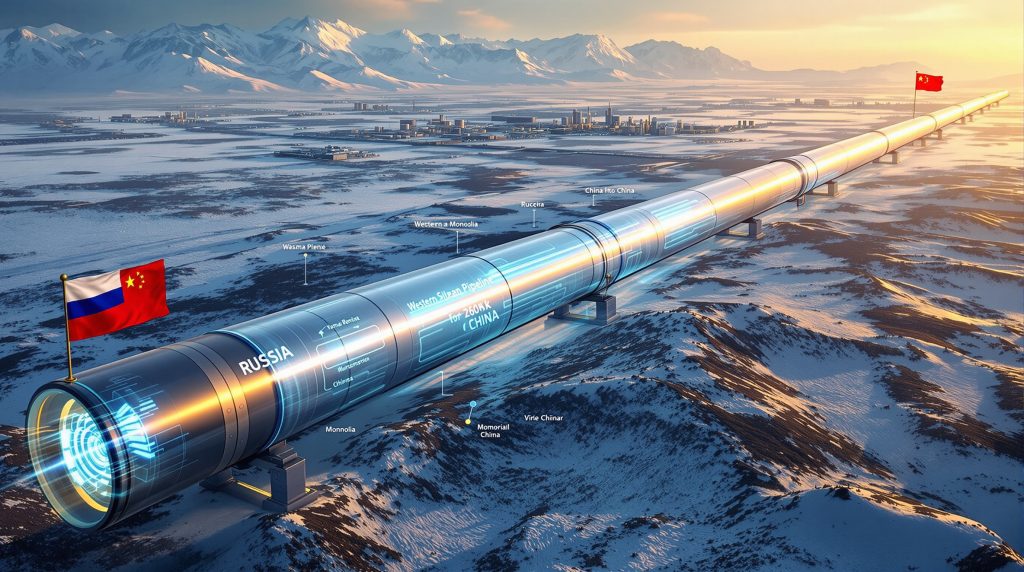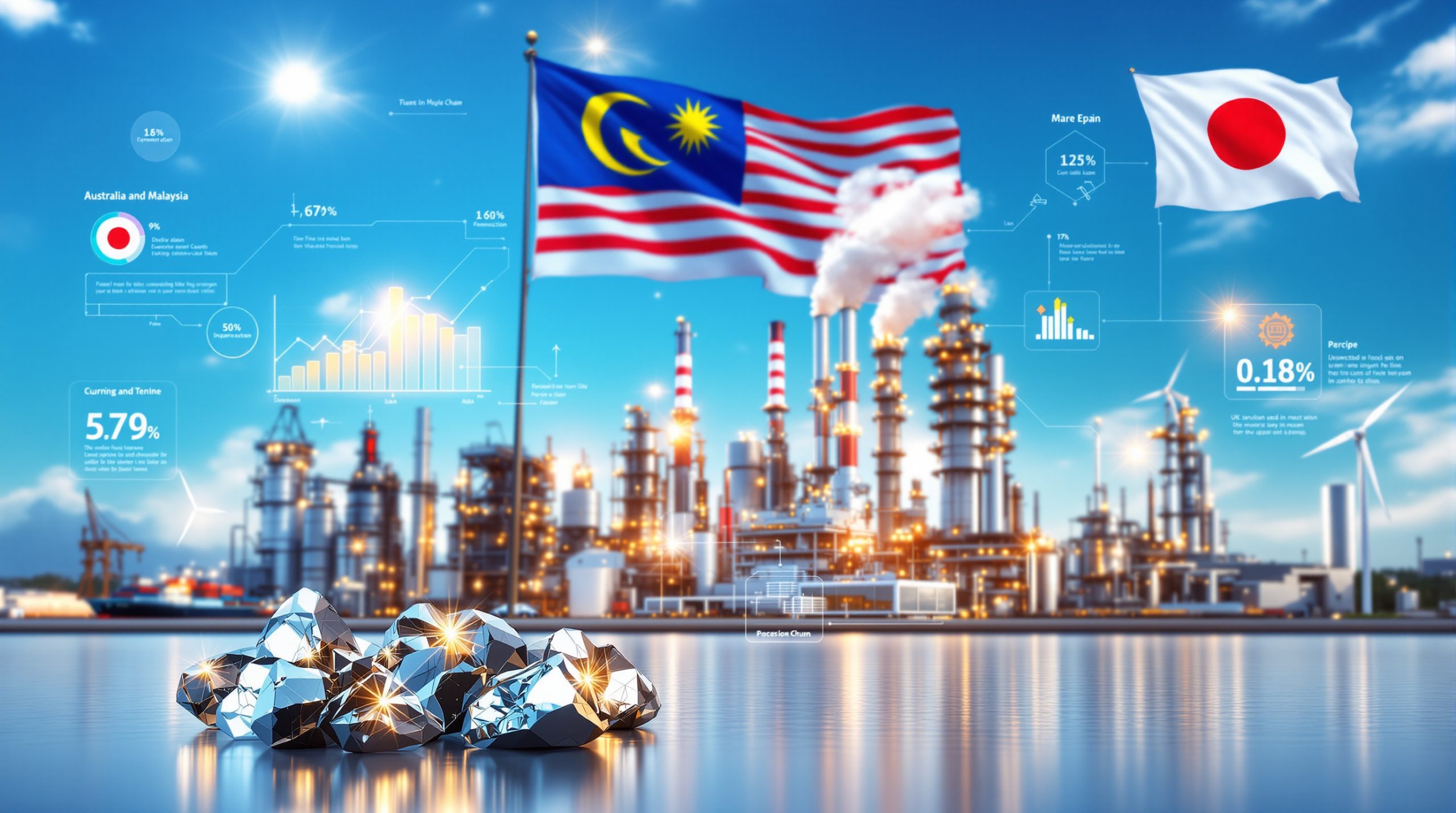What is the Power of Siberia 2 Pipeline?
The Power of Siberia 2 pipeline represents a strategic energy infrastructure project designed to transport natural gas from Russia's western Siberian fields to China via Mongolia. This second major gas corridor between Russia and China aims to deliver approximately 50 billion cubic meters (bcm) of natural gas annually, significantly expanding Russia's eastward energy exports.
Unlike its predecessor—the original Power of Siberia pipeline that began operations in 2019—this new route would connect different Russian gas fields to new markets in China, creating a more integrated Eurasian energy network. The project's strategic importance has grown substantially following Russia's pivot away from European markets amid the ongoing US‑China trade war impact.
The pipeline is designed to create a direct link between Russia's resource-rich western regions and China's growing energy demand centers, positioning itself as a cornerstone of Russia-China economic cooperation for decades to come.
How Does Power of Siberia 2 Fit into Russia's Energy Strategy?
Russia's Eastern Energy Pivot
Following the deterioration of Russia-Europe energy relations, Gazprom has accelerated its efforts to redirect gas flows eastward. The company reported its first annual loss in more than two decades after losing access to most European markets, making the Chinese market increasingly vital for Russia's energy sector.
This strategic reorientation comes amid the European Union's pledge to end dependency on Russian energy by the end of 2027, forcing Russia to secure alternative markets for its vast natural gas resources.
Strategic Diversification Benefits
For Russia, Power of Siberia 2 offers several strategic advantages:
- Creates alternative revenue streams to replace lost European market share
- Strengthens Russia's position in the growing Asian energy market
- Utilizes existing Western Siberian gas fields that previously supplied Europe
- Develops infrastructure in Russia's Far East and Siberian regions
The pipeline would transport gas from the Yamal Peninsula—Russia's primary gas-producing region that traditionally supplied Europe—creating a direct connection between Russia's western gas fields and eastern markets.
This pivot allows Russia to maintain production levels from its core gas fields while developing new commercial relationships in Asia, essentially converting a geopolitical challenge into a strategic opportunity.
What Route Will Power of Siberia 2 Follow?
Geographical Pathway
The proposed 2,600-kilometer pipeline would follow this route:
- Origin: Yamal Peninsula and Western Siberian gas fields (Altai region)
- Transit: Through Mongolia (approximately 960 kilometers)
- Destination: Northern China's industrial regions
This routing strategy connects Russia's gas-rich western regions directly to China's energy-hungry northern industrial centers, creating a new energy corridor across the Eurasian landmass.
Technical and Environmental Considerations
The current routing represents a significant modification from earlier plans:
- Original proposal: Direct Russia-China connection through the environmentally sensitive Altai Ukok Plateau
- Revised route: Longer path through Mongolia that avoids protected ecological zones
- Technical challenges: Crossing seismically active regions in Mongolia requires specialized engineering solutions
The Mongolia transit option adds complexity but offers political and environmental advantages compared to earlier direct routing proposals.
The revised route demonstrates how geopolitical considerations and environmental concerns have shaped the project's development, with the final path reflecting a balance between technical feasibility, ecological impact, and diplomatic relations.
What is the Current Status of the Project?
Recent Developments
In September 2023, Russia and China signed a legally binding memorandum during the Shanghai Cooperation Organization (SCO) summit, marking a significant step forward for the project. Gazprom CEO Alexey Miller announced the agreement with China's state energy firm CNPC, describing it as a milestone for the Power of Siberia 2 pipeline.
This memorandum represents the most concrete commitment to the project to date, following years of negotiations and preliminary discussions between the two energy powerhouses.
Key Outstanding Issues
Despite the memorandum, several critical elements remain unresolved:
- Pricing mechanism: Negotiations on gas pricing formulas continue
- Financing structure: Capital investment requirements and funding sources remain unclear
- Timeline uncertainties: Construction start date and completion schedule not finalized
- Capacity commitments: Final throughput volumes still under discussion
Mongolia's position also adds complexity—the country decided in mid-2024 not to include the pipeline in its government action plan through 2028, potentially delaying construction timelines.
Industry analysts suggest these unresolved elements could push the potential start-up years or even decades into the future, highlighting the significant work that remains despite the formal agreement.
What Are the Geopolitical Implications?
Strengthening Russia-China Relations
The Power of Siberia 2 project symbolizes the deepening strategic partnership between Russia and China, particularly in defiance of Western pressure. During the recent SCO summit, the two nations signed approximately two dozen agreements across various sectors, including energy, defense, and trade.
This energy partnership represents a concrete manifestation of the growing political alignment between Moscow and Beijing, creating economic interdependencies that reinforce their diplomatic cooperation amid concerns about Trump tariffs effects on global trade.
Changing Global Energy Dynamics
The pipeline project reflects broader shifts in global energy geopolitics:
- Accelerates the eastward reorientation of Russia's energy exports
- Strengthens China's energy security through diversified import sources
- Creates new economic interdependencies between Russia, China, and Mongolia
- Reduces Western influence over Eurasian energy flows
For the United States and its allies, this growing energy partnership represents a concerning development that could undermine the effectiveness of sanctions policies.
As noted by John Hardie, Russia Program Deputy Director at the Foundation for Defense of Democracies, "Whether Power of Siberia 2 will come to fruition remains to be seen. Regardless, there's no denying that the Sino-Russian partnership enhances the threat each country poses to U.S. interests."
What Are the Economic Considerations?
Investment Requirements
The Power of Siberia 2 represents a multi-billion-dollar investment:
- Estimated capital expenditure: $13.6 billion to $20 billion (varies by source)
- Pipeline infrastructure: Approximately $6.7 billion
- Supporting facilities: Gas processing plants, compressor stations, and connection infrastructure
These substantial capital requirements present a major financial hurdle, particularly given current economic sanctions and financing constraints facing Russian entities in global markets.
Economic Benefits for Participating Countries
Each country stands to gain different economic advantages:
Russia:
- New revenue streams to replace lost European gas sales
- Development of infrastructure in remote regions
- Utilization of existing gas fields with declining European demand
China:
- Enhanced energy security through diversified import sources
- Potential leverage for favorable pricing
- Development of northern industrial regions
Mongolia:
- Transit fees estimated at $1 billion annually
- Infrastructure development along the pipeline corridor
- Potential access to natural gas for domestic use
The economic distribution of benefits explains why the three nations have different levels of enthusiasm for the project, with Russia appearing most eager to move forward given its need to replace European market access.
How Does Power of Siberia 2 Compare to the Original Pipeline?
Key Differences Between the Two Projects
| Feature | Power of Siberia (Operational) | Power of Siberia 2 (Planned) |
|---|---|---|
| Capacity | 38 bcm/year (at full capacity) | 50 bcm/year (proposed) |
| Length | 3,000 kilometers | 2,600 kilometers (approximate) |
| Gas Source | Eastern Siberian fields (Chayanda, Kovykta) | Western Siberian fields (Yamal Peninsula) |
| Transit Countries | None (direct Russia-China) | Mongolia |
| Market Served | China's eastern provinces | China's northern regions |
| Current Status | Operational since 2019 | Memorandum signed, pre-construction |
| Investment | $55 billion (total project) | $13.6-20 billion (estimated) |
Complementary Nature
Rather than competing projects, the two pipelines would serve complementary roles in Russia's energy strategy:
- Power of Siberia connects isolated eastern Siberian gas fields to China's eastern provinces
- Power of Siberia 2 would link Russia's main western Siberian gas production to China's northern regions
- Together, they would create a more integrated Eurasian gas network
This complementary approach allows Russia to monetize gas reserves from different geographical regions while providing China with diverse supply sources that enhance its energy security posture.
What Challenges Does the Project Face?
Technical and Environmental Hurdles
The pipeline route presents several engineering challenges:
- Crossing seismically active zones in Mongolia
- Operating in extreme temperature conditions (from -40°C to +40°C)
- Minimizing environmental impact across sensitive ecosystems
- Coordinating construction across three countries with different standards
These technical challenges require specialized engineering solutions and careful environmental management to ensure the pipeline's safety, reliability, and sustainability.
Financial and Political Obstacles
Beyond technical issues, several other factors could delay or derail the project:
- Uncertainty about financing sources amid Western sanctions
- Potential pricing disputes between Russia and China
- Mongolia's changing position on hosting the pipeline
- Geopolitical pressures from Western countries
The project's success depends not only on engineering prowess but also on navigating complex diplomatic relationships and securing substantial financial commitments in a challenging international environment.
Timeline Uncertainties
While Russia has suggested construction could begin around 2024-2025, multiple factors make the timeline uncertain:
- Mongolia's decision to exclude the project from its 2028 planning horizon
- Ongoing negotiations on key commercial terms
- Potential technical and regulatory hurdles
- International sanctions impact on equipment and financing
As demonstrated by Russia's Arctic LNG 2 project, which faced significant delays due to Western sanctions, international restrictions can substantially impact timeline projections for major energy infrastructure.
What Would Power of Siberia 2 Mean for Global Gas Markets?
Market Impact Analysis
The pipeline would significantly reshape natural gas flows across Eurasia:
- Redirect up to 50 bcm annually from potential European markets to China
- Strengthen Russia's position as China's leading gas supplier
- Potentially impact LNG pricing dynamics in Asia
- Create new competition for other gas suppliers to China (including LNG exporters)
This redirection of substantial gas volumes would have cascading effects throughout global gas markets, potentially affecting pricing in both European and Asian markets. Furthermore, this could significantly influence the oil market trade war dynamics globally.
Supply-Demand Balance
For global gas markets, the project would:
- Help meet China's growing gas demand (projected to increase 50% by 2035)
- Reduce Russia's dependence on European markets
- Create more interconnected Eurasian gas networks
- Potentially limit Western influence on global gas pricing
The pipeline's development would cement China's position as the primary growth market for natural gas in the coming decades, potentially giving Beijing increased influence over global gas market dynamics. This shift comes at a crucial time when analysts are already concerned about declining US oil production and its impact on global energy security.
How Does This Project Reflect Changing Global Alliances?
Shifting Power Dynamics
The Power of Siberia 2 project exemplifies broader geopolitical realignments:
- Russia and China demonstrating strategic partnership despite Western pressure
- Growing economic integration among SCO member states
- Development of parallel financial and trade systems less vulnerable to Western sanctions
- Creation of energy infrastructure independent from Western influence
During the recent SCO summit, leaders from approximately 20 non-Western nations participated in discussions that signaled growing cooperation across multiple sectors, with energy being a central focus.
Western Response Considerations
For Western policymakers, the pipeline raises several concerns:
- Undermines the effectiveness of energy-focused sanctions
- Strengthens economic ties between countries challenging the Western-led order
- Creates new financial flows outside Western-controlled systems
- Demonstrates limits of Western influence over Eurasian energy development
As one analyst noted, "Beijing's willingness to further lean into Moscow's energy sector shows it no longer fears the consequence of U.S. sanctions. Washington must change that calculation."
This observation from Max Meizlish, Senior Research Analyst at the Foundation for Defense of Democracies, highlights how energy infrastructure projects have become focal points in broader geopolitical competition.
When Could Power of Siberia 2 Become Operational?
Timeline Projections
While exact dates remain uncertain, industry analysts suggest the following potential timeline:
- 2023-2024: Finalization of commercial agreements
- 2024-2025: Potential construction start (dependent on agreements)
- 2028-2030: Earliest possible partial operations
- 2030-2032: Full capacity operations (if construction proceeds as planned)
The 4-5 year construction timeline represents an optimistic scenario, with many factors potentially extending this period.
Key Milestones to Watch
Several critical developments will signal the project's progress:
- Final investment decision announcement
- Mongolia's formal approval and transit agreements
- Construction contract awards
- Equipment procurement milestones (particularly for specialized compressor technology)
Observers should monitor these concrete steps rather than political statements to gauge the project's true development status and likelihood of completion within projected timeframes. Additionally, understanding the relationship between tariffs and market investments will be crucial for assessing the economic viability of the project.
Conclusion: A Strategic Energy Partnership with Global Implications
The Power of Siberia 2 pipeline represents more than just an energy infrastructure project—it symbolizes the deepening strategic alignment between Russia and China in the face of Western pressure. By creating a second major gas corridor between these powers, the project would cement their energy partnership and reshape Eurasian energy flows for decades.
While significant obstacles remain—including financing challenges, pricing negotiations, and technical hurdles—the recent legally binding memorandum signals serious intent from both Russia and China to advance this strategic initiative. For global energy markets, the project's implementation would accelerate the eastward shift in Russia's gas exports and strengthen China's energy security through diversified import sources.
As geopolitical tensions continue to reshape global energy relationships, the Power of Siberia 2 pipeline stands as a concrete manifestation of the emerging multipolar energy order—one where Eurasian powers are creating new infrastructure connections largely independent from Western influence or control.
Looking to Capitalize on Resource Discoveries Before the Market Does?
Discovery Alert's proprietary Discovery IQ model instantly identifies significant ASX mineral discoveries, transforming complex geological data into actionable trading opportunities for investors of all experience levels. Visit our discoveries page to understand how major mineral finds have historically delivered extraordinary market returns, and start your 30-day free trial today.




